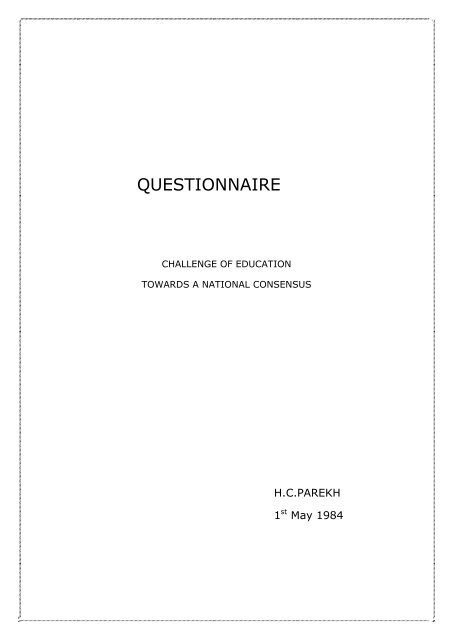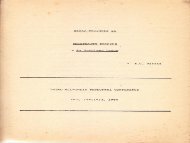QUESTIONNAIRE
Create successful ePaper yourself
Turn your PDF publications into a flip-book with our unique Google optimized e-Paper software.
<strong>QUESTIONNAIRE</strong><br />
CHALLENGE OF EDUCATION<br />
TOWARDS A NATIONAL CONSENSUS<br />
H.C.PAREKH<br />
1 st May 1984
1. ENROLMENT (PRIMARY & MIDDLE LEVELS) ONLY 76%<br />
Enrolment at primary and Middle levels with respect to the<br />
corresponding age- group ( 6-14 Years) is only 76% in India, as<br />
against 117% in China, 112% in France, 107% in Singapore, 106% in<br />
U.S.S.R., 101% in Japan and 98% in the U.S.A.<br />
On the basis of the present population and conditions, raising the<br />
enrolment at these levels by one percentile point will need:<br />
- 6353 additional SCHOOLS<br />
- 22690 additional TEACHERS<br />
- Rs. 25 Crore of additional EXPENDITURE p.a.<br />
In the light of the above, do you feel that the enrolment at Primary<br />
and Middle levels in India should:<br />
1.1 remain at the present level, i.e. around 76% ?<br />
1.2 be boosted to 100% ?<br />
1.3 be boosted to beyond 100% ?
2. MIDDLE LEVEL EDUCATION<br />
( Age Group 11-14 years – std. VI – VIII)<br />
Number ( in lakhs) of : 1950 1984<br />
--------------------------------------------------------------------------------<br />
- Primary Schools 2.01 5.09<br />
- Middle level Schools 0.13 1.26<br />
Therefore,<br />
Ratio of Middle level school : Primary Schools 1 : 15 1 : 4<br />
This means that for<br />
* every 15 primary schools, we had 1 Middle level School in 1950,<br />
* whereas for every 4 Primary schools we have 1 Middle level school<br />
in 1984.<br />
Increasing 1 more Middle level school for every 4 Primary Schools will<br />
mean :<br />
- 1.26 lakhs additional MIDDLE LEVEL SCHOOLS<br />
- 8.78 lakhs additional TEACHERS<br />
- 250 lakhs more CHILDREN could be ENROLLED in Middle level<br />
Schools.
In view of the above, for every 4 Primary Schools, how many Middle<br />
Level should we have ? Enter your number below :<br />
2.1.1 Same number As at present<br />
2.2.2<br />
2.3.3<br />
2.4.4<br />
As laid down in the constitution, education up to the age of 14 years (<br />
i.e. till Middle level ) is the responsibility of the Government, i.e. it<br />
should be compulsory and free :<br />
Do you subscribe to this view ?<br />
2.5 Yes<br />
2.6 No
3 ENROLMENT OF GIRLS ( COMPARED WITH BOYS )<br />
Enrolment as a percentage of eligible population is as Under :<br />
Boys Girls Total<br />
--------------------------------<br />
- Primary level 110 76 93<br />
- Middle level 63 34 49<br />
- Secondary level 33 16 25<br />
In view of the fact that 48% population of India is that of females,<br />
do you agree that :<br />
3.1 Primary education for girls should be made compulsory ?<br />
3.1.1 Yes<br />
3.1.2 No<br />
3.2 Secondary education should be free for girls ?<br />
3.2.1 Yes<br />
3.2.2 No<br />
Making Primary education for girls compulsory will require additional<br />
resources in terms of :<br />
- 65,900..... Primary SCHOOLS<br />
- 1,80,000.. TEACHERS<br />
- Rs. 246 Crores of EXPENDITURES p.a.
4 OUTLAY ON EDUCATION<br />
- India spends 3% of its Gross National Product ( GNP) on education.<br />
- Developed Countries spend about 8%<br />
- 1968 Review Committee recommended 6%<br />
Do you think that the allocation on education as a percentage of GNP<br />
should be :<br />
4.1 3 % ? ( Present situation )<br />
4.2 6 % ?<br />
4.3 8 % ?<br />
4.4 10% ?<br />
India’s GNP for the year 1983-84 is estimated at about Rs. 1,72,000<br />
crores.
5 DIFFERENTIAL EXPENDITURE ON EDUCATION IN STATES<br />
5<br />
In 1983-84, per capita budgeted expenditure on education in some of<br />
the major states was as under :-<br />
State<br />
Expenditure ( Rs.)<br />
--------------------------------------------------------<br />
U.P. 49.5 ( lowest among major States )<br />
M.P. 56.7<br />
Bihar 69.2<br />
Punjab 121.2<br />
Kerala 130.4 ( highest among major states )<br />
All India 81.0<br />
This shows that poorer and backward states spend less amount on<br />
education.<br />
In view of the above, do you agree to the followingviews ?<br />
5.1 No states should be allowed to spend less that the present national<br />
average of per capita outlay on education.<br />
5.1.1 Yes<br />
5.2.2 No<br />
5.2 Education opportunities should be equally and evenly spread and<br />
grown in all the states.
5.2.1 Yes<br />
5.2.2 No<br />
5.3 Backward States should pump in far greater resources on<br />
education for upliftment of masses.<br />
5.3.1 Yes<br />
5.3.2 No<br />
5.4 Depending on the prosperity and literacy level, States should<br />
decide the amount of per capita expenditure on education.<br />
5.4.1 Yes<br />
5.4.2 No
6. PRIVATE DONATIONS FOR EDUCATION<br />
Private donations toward education as a percentage of total<br />
expenditure on education were as under :<br />
Year %<br />
------------------------------------------------------------------------------<br />
1900- 1901 25.0<br />
1950-1951 11.6<br />
1980-81 3.0<br />
6.1 Should private donations, in your opinion, as a percentage of<br />
total expenditure on education, be in the range of :<br />
6.1:1.. 0% - 10%<br />
6.1:2.. 10% - 20%<br />
6.1:3.. 20% - 30%<br />
6.1:4... > 30%<br />
6.2 Further, do you agree that all donations towards educational<br />
purpose must qualify for a weighted deduction ( say, at the<br />
rate of 150% ) under the Income Tax Act ?<br />
6.2.1 Yes<br />
6.2.2 No<br />
Total expenditures on education was Rs. 1537 Crores in 1980-81.
7. AUDIT OF EDUCATION<br />
8.<br />
Today, hardly any audit is being conducted on :<br />
o Process of education<br />
o Quality of teachers<br />
o Expenditures in Institutes<br />
o Facilities<br />
o Machinery and Equipment<br />
In view of this, do you subscribe to the following views ?<br />
7.1 Bi-annual audit in prescribe forms must be conducted by a<br />
committee consisting of educationists, industrialists and other<br />
prominent citizens appointed by affiliating universities/ boards.<br />
7.1.1 Yes<br />
7.2.2 No<br />
7.2 Those who fail to meet audit standards must be stopped to function<br />
( not merely derecognized ).<br />
7.2.1 Yes<br />
7.2.2 No
8. REQUISITE NORMS FOR EDUCATIONAL INSITUTES<br />
There are hardly any well laid down and known NORMS for allowing new<br />
educational institutions formation.<br />
Do you agree that ,<br />
8.1 for each branch of education, broad as well as detailed guidelines<br />
must be specified ?<br />
8.1.1 Yes<br />
8.1.2 No<br />
8.2 no educational institution should be permitted to commence classes,<br />
unless and until, an independent, impartial Audit Team certifies that<br />
the requirements laid down as per NORMS have been fulfilled ?<br />
8.2.1 Yes<br />
8.2.2 No
9. TEACHER PUPIL RATIO<br />
The Teacher - Pupil Ratio in India was as under in 1983-84 :<br />
a) Primary - level schools 1 : 64<br />
b) Middle - level School 1 : 58<br />
c) Secondary/ Higher 1 : 47<br />
secondary schools<br />
d) Overall for the above 1 : 57<br />
Do you feel that an ideal ratio ,<br />
9.1 For primary – level schools should be :<br />
9.1.1 1 : 64 ?<br />
9.1.2 1 : 50 ?<br />
9.1.3 1 : 30 ?<br />
9.2 For middle – level schools should be :<br />
9.2.1 1 : 58 ?<br />
9.2.2 1 : 40 ?<br />
9.2.3 1 : 25 ?<br />
9.3 For secondary/ Higher secondary schools should be :<br />
9.3.1 1 : 47 ?
9.3.2 1 : 30 ?<br />
9.3.3 1 : 20 ?<br />
9.4 Over – all for the above-mentioned levels should be :<br />
9.4.1 1 : 57 ?<br />
9.4.2 1 : 40 ?<br />
9.4.3 1 : 30 ?<br />
For improving the overall ratio from the present level of 1:57 to<br />
1:30, we shall need the number of teachers to go up from the<br />
present 33.02 lakhs to 62.73 lakhs, assuming the total enrolment<br />
being constant.
10. TEACHERS MOTIVATION<br />
Teachers are not sufficiently motivated to improve the quality of<br />
education and take an active interest in the educational process since:-<br />
- Even their physical needs like housing, proper salary, education for<br />
their own children, etc. are not met fully :<br />
- Esteem need is not met since they do not enjoy sufficient status in<br />
the social strata.<br />
- Environment for meeting Self-Actualization needs does not exists.<br />
To what extent do you feel the following measures would contribute<br />
toward raising teachers motivation level?<br />
Great ..Fair..Little..None<br />
10.1 Meet the basic physical (10.1:1)( 10.1:2)(10.1:3)(10.1:4)<br />
needsof the teachers<br />
community<br />
10.2 Make teachers accountable 10.2:1 10.2:2 10.2:3 10.2:4<br />
10.3 improve work ethos 10.3:1 10.3:2 10.3:3 10.3:4<br />
10.4 Employ qualified teachers 10.4:1 10.4:2 10.4:3 10.4:4<br />
having integrity and<br />
devotionfor the profession<br />
10.5 Introduce performance 10.5:1 10.5:2 10.5:3 10.5:4<br />
basedpromotion scheme
10.6 Create environment wherein 10.6:1 10.6:2 10.6:3 10.6:4<br />
they can undertake research<br />
and develop institutional<br />
instructional material and<br />
thereby have a sense of<br />
achievement.
11. INDUSTRY – INSTITUTE- INTERACTION – ADEQUACY<br />
Some of the advantages of Industry – Institute interaction are<br />
believed to be that Technical education will be more in tune with the<br />
real life situation and the latest technology, and teachers would feel<br />
more inspired and motivated.<br />
Do you feel that the level of Industry- Institute interaction in case of<br />
the following is :<br />
More than Fairly Inadequate Zero<br />
adequate<br />
11.1 Non-technical 11.1:1 11.1:2 11.1:3 11.1:4<br />
graduate<br />
colleges<br />
11.2 Technical college 11.2:1 11.2:2 11.2:3 11.2:4<br />
Diploma level<br />
11.3 Technical college 11.3:1 11.3:2 11.3:3 11.3:4<br />
Degree level<br />
11.4 Management 11.4:1 11.4:2 11.4:3 11.4:4<br />
Institutions<br />
11.5 Research 11.5:1 11.5:2 11.5:3 11.5:4<br />
Institutions
12. INDUSTRY – INSTITUTE INTERACTION – METHODOLOGY<br />
Given below are some methods by which Industry – Institute<br />
interaction may be increased :<br />
Kindly evaluate these methods, on a 4-point scale:<br />
Very Good Fair Ineffective<br />
Good<br />
12.1 Industries should 12.1:1 12.1:2 12.1:3 12.1:4<br />
adopt existing<br />
institutions for<br />
transfer of knowledge<br />
12.2 Industry should 12.2:1 12.2:2 12.2:3 12.2:4<br />
organiseTraining<br />
for teachers<br />
12.3 project-assignment 12.3:1 12.3:2 12.3:3 12.3:4<br />
work for students<br />
should form a<br />
large percentage of<br />
the curriculum.
13. VOCATIONAL INSTITUTES - STATEWISE DISTRIBUTIONS<br />
At present 66% of the 1600 Vocational Institutes ( Industrial) are<br />
located in Maharashtra and Tamil Nadu, which have only 16% of the<br />
total population. Presently almost all these institutions are governed<br />
by the State Governments.<br />
To what extent do you feel, a more equitable distribution of<br />
vocational Institutes is possible by the following measures?<br />
Great Fair Little None<br />
13.1 Industrial Houses 13.1:1 13.1:2 13.1:3 13.1:4<br />
shouldbe encouraged<br />
to set upvocational<br />
Institutes<br />
13.2 State Government 13.2:1 13.2:2 13.2:3 13.2:4<br />
should increase<br />
funds outlay for<br />
Vocational Institutes
14. LITERACY LEVEL – GROWTH RATE<br />
Progress of literacy, in India as measured by the percentage of<br />
literates to the population in the last five census years is as under :-<br />
---------------------------------------------------------------------------<br />
Census Year Total Male Female<br />
----------------------------------------------------------------------------<br />
1941 16.1% 24.9% 7.3%<br />
1951 16.7% 25.0% 7.9%<br />
1961 24.0% 34.4% 13.0%<br />
1971 29.5% 39.5% 18.7%<br />
1981 36.2% 46.7% 24.9%<br />
Growth in 1981over 1941 241.1% 124.8% 87.5%<br />
In the light of this, do you feel that the thrust of our education<br />
policy in this matter should be :-<br />
14.1 Keep growth in literacy rates at the existing levels<br />
14.2 Striving for much higher growth In literacy rates for males as<br />
compared to growth in female literacy rate.<br />
14.3 Strive for much higher growth in literacy rates for females<br />
than what is obtained up to 1981.
15. PHYSICAL FACILITIES<br />
Following are the extent of basic facilities possessed by our<br />
educational institutions :<br />
- 60.3% of schools have blackboards<br />
- 29.5% of schools have libraries<br />
- 46.6% of schools have play- grounds<br />
- 91.0% of schools have buildings<br />
What do you feel are the levels to which these facilities should be raised<br />
to ?<br />
15.1 Schools having black – board:<br />
15.1.1 70%<br />
15.1.2 80%<br />
15.1.3 90%<br />
15.1.4 100%<br />
15.2 Schools having libraries :<br />
15.2.1 40%<br />
15.2.2 60%<br />
15.2.3 80%<br />
15.2.4 100%
15.3 Schools having play- grounds<br />
15.3.1 60%<br />
15.3.2 80%<br />
15.3.3 100%<br />
15.4 Schools having buildings :<br />
15.4.1 95%<br />
15.4.2 100%
16. EXAMINATION SYSYTEM<br />
Do you feel that the following statement are :<br />
Completely Mainly Partially Completely<br />
True True True False<br />
16.1 The examination 16.1.1 16.1.2 16.1.3 16.1.4<br />
system at present<br />
encourage memorizing<br />
and cramming rather<br />
than understanding<br />
and learning<br />
16.2 Examination at the 16.2.1 16.2.2 16.2.3 16.2.4<br />
end of the year<br />
drive pupils to study<br />
only in the last lap.<br />
16.3 The examination 16.3.1 16.3.2 16.3.3 16.3.4<br />
systems does not<br />
truly reflect the<br />
potential / aptitude/<br />
knowledge acquired by<br />
the pupil.
17. EXAMINATION SYSTEM<br />
A “ Credit point System” of promotion as practiced in some of the<br />
advanced countries permits everyone to set one's own pace of<br />
learning. Students could be promoted to the next class on<br />
accumulation of certain minimum number of credit point. This would<br />
enable bright student to complete formal education faster.<br />
Would you agree that it is necessary in India to shift to the “Credit<br />
Point System?<br />
17.1 Yes<br />
17.2 No
18 DIGNITY OF LABOUR<br />
18.1 Would you consider it true that our present education system<br />
induces people to opt For white- collar jobs ?<br />
18.1.1 Yes<br />
18.1.2 No<br />
18.2 Do you feel that student should be made to engage<br />
themselves in physical work such as compulsory commissions<br />
in para-military forces, practical learning of crafts,<br />
compulsory tree-plantation, upkeep of community amenities,<br />
upkeep of educational institutes, etc. to restore the dignity of<br />
labour ?<br />
18.2.1 Yes<br />
18.2.2 No
19 AGRICULTURAL VOCATIONAL INSTITUTE<br />
At present, Agricultural Education is available only at Graduates<br />
Level, except for Agricultural Machinery ( Mechanics ) at Vocational<br />
level in a very few colleges .<br />
This results in rural population, going into cities for entering into<br />
vocational institutes relevant to Industry only.<br />
19.1 Is it desirable, in your opinion, to set up Agricultural Vocational<br />
Institutes in rural areas to impart courses such as Agriculture,<br />
Horticulture, Forestry, Canning, Food preservation, Animal<br />
Husbandry, Pantry Sericulture, Honey extraction, Bio-gas, Fishseed<br />
cultivation, etc.?<br />
19.1.1 Yes<br />
19.1.2 No<br />
19.2 Do you feel such AgriculturalVocational Institutions could be<br />
financed by suitably taxing farm income?<br />
19.2.1 Yes<br />
19.2.2 No
20. ENROLMENT IN HIGHER EDUCATION<br />
Total enrolment in higher education in 1983-84 is estimated at<br />
33.59 lakhs out of 1243 lakhs total enrolment, i.e. 2.7%<br />
Do you think that this percentage ( 2.7 % ) :<br />
20.1 Is adequate ?<br />
20.2 Should be raised to 5%?<br />
20.3 Should be raised to 10%?<br />
20.4 Should be raised to 15%?<br />
At the 1983-84 level of total enrolment, raising enrolment in higher<br />
education by one percentile point will need :<br />
- About 1940 additional colleges<br />
- About 81,240 additional teachers
21 PLAN OUTLAY ON ELEMENTARY EDUCATION<br />
Share of plan outlay on " Elementary Education ", from the total<br />
outlay on education has been as follows :<br />
1 ST Plan 55%<br />
2 nd Plan 34%<br />
3 rd Plan 37%<br />
4 th Plan 31%<br />
5 th Plan 32%<br />
6 th Plan 36%<br />
7 th Plan 34%<br />
21.1 Do you agree that the 7 th plan outlay on elementary education<br />
is adequate ?<br />
21.1.1 Yes<br />
21.1.2 No<br />
21.2 If no, what in your opinion it should be ? ...…%<br />
o Total 7 th Plan outlay on education is R. 5457 Crores.<br />
o Allocation of 34% on elementary education is equal to<br />
Rs.1855 Crores – over a period of five years, i.e. Rs.371<br />
Crores p.a.<br />
o Plan budgeted expenditure for 1983-84 is Rs.230 Crores, on<br />
elementary education.<br />
o Literacy level as per 1981 census is 36.2%
















